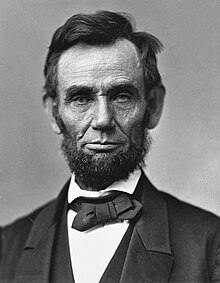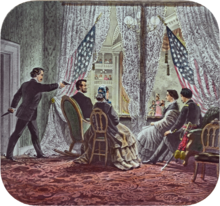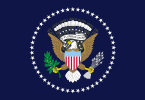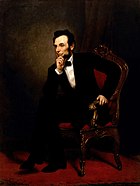Abraham Lincoln
Abraham Lincoln | |
|---|---|
 Portrait by Alexander Gardner, November 1863 | |
| 16th President of the United States | |
| In office March 4, 1861 – April 15, 1865 | |
| Vice President | Hannibal Hamlin (1861–1865) Andrew Johnson (March–April 1865) |
| Preceded by | James Buchanan |
| Succeeded by | Andrew Johnson |
| Member of the U.S. House of Representatives from Illinois's 7th district | |
| In office March 4, 1847 – March 4, 1849 | |
| Preceded by | John Henry |
| Succeeded by | Thomas Harris |
| Personal details | |
| Born | February 12, 1809 Hodgenville, Kentucky, U.S. |
| Died | April 15, 1865 (aged 56) Washington, D.C. |
| Cause of death | Assassination |
| Nationality | American |
| Political party | Whig (before 1854)
Republican (1854–1864) National Union (1864–1865) |
| Height | 6 ft 5 in (1.96 m) |
| Spouse(s) | Mary Todd Lincoln |
| Religion | Baptists |
| Signature | |
Abraham Lincoln (February 12, 1809 – April 15, 1865) was an American politician who was the 16th president of the United States from 1861 until his assassination in 1865, during the American Civil War. Just five days after most of the Confederate forces had surrendered and the war was ending, John Wilkes Booth assassinated Lincoln. Lincoln was the first president of the United States to be assassinated. Lincoln has been remembered as the "Great Emancipator" because he worked to end slavery in the United States.[1] Lincoln is ranked in presidential opinion polls as the greatest president in U.S. history. [2]
Life
[change | change source]Abraham Lincoln was born on February 12, 1809, in Hodgenville, Kentucky, United States. His parents were Thomas Lincoln and Nancy Hanks. His family was very poor.[3] Abraham had one brother and one sister. His brother died in childhood. They grew up in a small log cabin, with just one room inside. Although slavery was legal in Kentucky at that time, Lincoln's father, who was a religious Baptist, refused to own any slaves.
When Lincoln was seven years old, his family moved to Indiana. Later they moved to Illinois.[4] In his childhood he helped his father on the farm, but when he was 22 years old he left home and moved to New Salem, Illinois, where he worked in a general store.[5] Later, he said that he had gone to school for just one year, but that was enough to learn how to read, write, and do simple math. When he was 21, he worked on a flatboat that carried freight. In 1842, he married Mary Todd. They had four children, but three of them died when they were very young.[6] Abraham Lincoln was sometimes called Abe Lincoln or "Honest Abe" because of a legend stating that he ran miles to give a customer the right amount of change. The nickname "Honest Abe" came from a time when he started a business that failed. Instead of running away like many people would have, he stayed and worked to pay his debt.[7]
Early political career
[change | change source]Lincoln started his political career in 1832 when he ran for the Illinois General Assembly, but he lost the election. He served as a captain in the Illinois militia during the Black Hawk War, a war with Native American tribes. When he moved to Springfield in 1837, he began to work as a lawyer. Soon, he became one of the most highly respected lawyers in Illinois.[8][9] In 1837, as a member of the Illinois General Assembly, Lincoln issued a written protest of its passage of a resolution stating that slavery could not be abolished in Washington, D.C.[10][11]
In 1841, he won a court case (Bailey v. Cromwell). He represented a black woman who claimed she had already been freed and could not be sold as a slave. In 1847, he lost a case (Matson v. Rutherford) representing a slave owner (Robert Matson) claiming the return of fugitive slaves. After he moved to Illinois, he worked as a shopkeeper and postmaster. He rode the circuit of courts for many years.
In 1846, Lincoln joined the Whig Party and was elected to one term in the House of Representatives. After that, he ignored his political career and instead worked as a lawyer. In 1854, in reaction to the passage of the Kansas-Nebraska Act, Lincoln became involved in politics again. He joined the Republican Party, which had recently been formed in opposition to the expansion of slavery. In 1858, he wanted to become senator. He ran for senate against Stephen A. Douglas. Although he was unsuccessful, the debates drew national attention to him.[12] The Republican Party nominated him for the Presidential election of 1860.[13]
Presidency
[change | change source]
Lincoln was chosen as a candidate for the Republican Party, the second candidate to be nominated from the party. He was chosen in 1860 for different reasons. Among these reasons was that his views on slavery were less extreme than those of other people who wanted to be candidates. Lincoln was from what was then one of the Western states and had a bigger chance of winning the election there. Other candidates that were older or more experienced than him had enemies inside the party.[14][15] Lincoln's family was poor, which added to the Republican position of free labor, the opposite of slave labor. Lincoln won the election in 1860 and was made the 16th President of the United States. He won with almost no votes in the South. For the first time, a president had won the election because of the large support he got from the states in the North.[15] During his presidency Lincoln became well known because of his large stovepipe hat. He used his tall hat to store papers and documents when he was traveling.[16]
The Civil War
[change | change source]
After Lincoln's election in 1860, seven States (South Carolina, Mississippi, Alabama, Florida, Georgia, Texas and Louisiana) formed the Confederate States of America. When the United States refused to surrender Fort Sumter in Charleston, South Carolina, the Confederates attacked the fort, beginning the American Civil War. Later, four more states (Arkansas, Virginia, Tennessee, and North Carolina) joined the Confederacy for a total of eleven. In his whole period as president, he had to rebuild the Union with military force and many bloody battles. He also had to stop the "border states", like Kentucky, Missouri, and Maryland, from leaving the Union and joining the Confederacy.
Lincoln was not a general, and had only been in the army for a short time during the Black Hawk War.[17] However, he still took a major role in the war, often spending days and days in the War Department. His plan was to cut off the South by surrounding it with ships, control the Mississippi River, and take Richmond, the Confederate capital. He often clashed with generals in the field, especially George B. McClellan, and fired generals who lost battles or were not aggressive enough. Eventually, he made Ulysses S. Grant the top general in the army.
Emancipation Proclamation
[change | change source]With the Emancipation Proclamation begun on January 1, 1863, Lincoln ordered the freedom of all slaves in those states still in rebellion during the American Civil War. It did not actually immediately free all those slaves however, since those areas were still controlled by the rebelling states of the Confederacy. Only a small number of slaves already behind Union lines were immediately freed. As the Union army advanced, nearly all four million slaves were effectively freed. Some former slaves joined the Union army after 1862. The Proclamation also did not free slaves in the slave states that had remained loyal to the Union (the federal government of the US). Neither did it apply to areas where Union forces had already regained control, as in Tennessee.[1] Until the Thirteenth Amendment to the U.S. Constitution in 1865, only the states had power to end slavery within their own borders, so Lincoln issued the proclamation as a war measure.
The Proclamation made freeing the slaves a Union goal for the war, and put an end to movements in European nations (especially in Great Britain and France) that would have recognized the Confederacy as an independent nation. Lincoln then sponsored a constitutional amendment to free all slaves. The Thirteenth Amendment, making slavery illegal everywhere in the United States, was passed late in 1865, eight months after Lincoln was assassinated.
Gettysburg Address
[change | change source]Lincoln made a famous speech after the Battle of Gettysburg in 1863 called the Gettysburg Address. The battle was very important, and many soldiers from both sides died. The speech was given at the new cemetery for the dead soldiers. It is one of the most famous speeches in American history.[18]
Second term and assassination
[change | change source]Lincoln was re-elected president by a small number of votes in 1864 and re-inaugurated on March 4, 1865. Soon afterward, it appeared likely that the Union would win the Civil War. Lincoln wanted to make it easy for states that had rebelled to restore self-government. On April 9, 1865, the leading Confederate general, Robert E. Lee, surrendered his armies. On April 11, 1865, Lincoln gave a speech in which he promoted voting rights for black American citizens.[19]

During the day on April 14, 1865, Lincoln signed the law that created the secret service, the US President's security force. On the evening of April 14, Lincoln went to attend a play with his wife, Mary Todd at Ford's Theater in Washington, D.C.. He had invited Ulysses S. Grant to attend the play with him and his wife Mary Todd, and Grant planned to attend. As a general, Grant would have brought his own extra military security force, but he did not attend the play because his wife Julia and Mary Todd did not get along well.
During the third act of the play, John Wilkes Booth, a well-known actor and a Confederate spy from Maryland, entered the presidential box and shot Lincoln at point-blank range,[20] mortally wounding him and screamed "Sic semper tyrannis" ("Thus always to tyrants"). An unconscious Lincoln was carried across the street to Petersen House. He was placed diagonally on the bed because his tall frame would not fit normally on the smaller bed.[21] He remained in a coma for nine hours before dying the next morning.[22] According to some accounts, at his last drawn breath, on the morning after the assassination, he smiled broadly and then expired.[23] Lincoln was the first American president to be assassinated.[24]
Booth escaped but died from shots fired during his capture on April 26.
Legacy
[change | change source]
Lincoln has been consistently ranked both by scholars[25] and the public[26] as one of the greatest U.S. presidents. He is often considered the greatest president in American history for his leadership during the American Civil War and his eloquence in speeches such as the Gettysburg Address.
References
[change | change source]- ↑ 1.0 1.1 "Lincoln". Yale University. Retrieved August 22, 2009.
- ↑ Burlingame, Michael (October 4, 2016). "Abraham Lincoln: Impact and Legacy | Miller Center". millercenter.org. Retrieved September 11, 2023.
- ↑ Thornton, Brian; Richard W. Donley (October 31, 2005). 101 things you didn't know about Lincoln: loves and losses, political power. Adams Media. ISBN 978-1-59337-399-3.
- ↑ "Lincoln Trail Homestead State Park". Abraham Lincoln Online. Archived from the original on April 15, 2012. Retrieved May 21, 2008.
- ↑ Fehrenbacher, Don (1989). Speeches and Writings 1859-1865. Library of America. p. 163. ISBN 9780940450639.
- ↑ Goodwin, Doris Kearns (2005). Team of Rivals. New York, NY: Simon & Schuster, Inc. ISBN 9780684824901.
- ↑ White, Jr., Ronald C. (2009). A. Lincoln: A Biography. Random House, Inc. ISBN 9781400064991
- ↑ Frank, John (1991). Lincoln as a Lawyer. Americana House. ISBN 0962529028.
- ↑ "Biography of Lincoln". Quotable Lincoln. Archived from the original on January 4, 2010. Retrieved August 28, 2009.
- ↑ "Lincoln on Slavery". Retrieved November 15, 2009.
- ↑ "Protest in Illinois Legislature on Slavery". University of Michigan Library. March 3, 1937. Retrieved November 15, 2009.
- ↑ Lincoln, Abraham (June 1858). "A House Divided Against Itself Cannot Stand". National Center for Public Policy Research. Retrieved May 21, 2008.
- ↑ "Abraham Lincoln". history.com.
- ↑ Boritt, Gabor S. (1997). Why the Civil War Came. Oxford University Press. pp. 3–30. ISBN 0195113764.
- ↑ 15.0 15.1 Blum, John M. (1981). Team of Rivals. New York, NY: Harcourt Brace Jovanovich. pp. 340–342.
- ↑ Abe Lincoln's Hat Step into Reading Books Series A Step 2 Book by Martha Brenner Books at epinions.com
- ↑ "Captain Abraham Lincoln Archived 2006-07-18 at the Wayback Machine", Illinois State Military Museum, Illinois National Guard, accessed April 12, 2009.
- ↑ "Outline of U.S. History". United States Department of State. p. 73. Archived from the original on October 20, 2012. Retrieved January 3, 2009.
- ↑ "Last Public Address". Speeches and Writings. showcase.netins.net/web/creative/lincoln.html, Abraham Lincoln Online. April 11, 1865. Archived from the original on June 6, 2011. Retrieved September 15, 2008.
- ↑ Swanson, James. Manhunt: The 12-Day Chase for Lincoln's Killer. Harper Collins, 2006. pp. 42–3. ISBN 978-0-06-051849-3
- ↑ Steers, Edward. Blood on the Moon: The Assassination of Abraham Lincoln. University Press of Kentucky, 2001. p. 123–24. ISBN 978-0-8131-9151-5
- ↑ "Abraham Lincoln". History. AETN UK. Retrieved February 16, 2014.
- ↑ Fox, Richard (2015). Lincoln's Body: A Cultural History. W. W. Norton & Company. ISBN 978-0393247244.
- ↑ Swanson, James (2006). Manhunt: The 12-Day Chase for Lincoln's Killer. Harper Collins. ISBN 9780060518493.
- ↑ "Ranking Our Presidents" Archived 2017-08-11 at the Wayback Machine. James Lindgren. November 16, 2000. International World History Project.
- ↑ "Americans Say Reagan Is the Greatest President". Gallup Inc. February 28, 2011.
Other websites
[change | change source]- The Lincoln Institute
- Abraham Lincoln Research Site
- A One Page Summary of Abraham Lincoln's Life
- Abraham Lincoln at Find a Grave
- Lincoln's White House biography Archived 2006-12-05 at the Wayback Machine
- Abraham Lincoln -Citizendium
- Abe Lincoln History Site Archived 2016-02-08 at the Wayback Machine
- Presidents of the United States
- 1809 births
- 1865 deaths
- Abraham Lincoln
- American abolitionists
- Assassinated presidents of the United States
- Deaths by firearm in the United States
- Politicians from Springfield, Illinois
- Politicians from Kentucky
- United States representatives from Illinois
- American Civil War
- 19th-century American politicians
- Nationalists
- Republican Party (United States) politicians
- Lawyers from Kentucky
- Lawyers from Illinois



